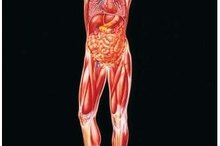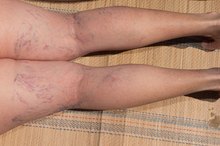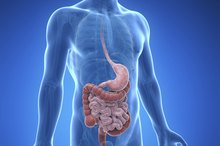Atherosclerotic Disease of the Abdominal Aorta Symptoms
The atherosclerotic disease of the abdominal aorta is commonly known as abdominal aortic aneurysm (AAA) 34. Medline Plus states that most abdominal aortic aneurysms are caused by atherosclerosis, a fatty deposit of the inner lining of the arteries. The International Society for Cardiovascular Surgery considers the diagnosis of AAA if a diameter is greater than 3 cm. The most characterized manifestations of AAA, According to the Society of Thoracic Surgeons, are pain, abdominal symptoms, symptoms of poor blood flow and shock.
If you are experiencing serious medical symptoms, seek emergency treatment immediately.
Pain
According to the Mayo Clinic, AAA does not usually cause any symptoms until it becomes very large or ruptures. It is often discovered during routine physical exams or procedure for unrelated illnesses. The first indication of abdominal aortic aneurysm is often severe chest pain 123. If an aneurysm begins to leak, deep back or groin pain often occurs. This pain may not respond to pain medication or position changes, Milton S. Hershey Medical Center, College of Medicine notes 2.
Abdominal Symptoms
Abdominal Hernia Signs & Symptoms
Learn More
According to the Preview of the Medifocus Guidebook on AAA in 2010, abdominal pain can be felt 1. Pain can be felt in the abdomen or the fleshy part of patient sides between the bottom of ribs and hips. There may be a rhythmic, pulsating sensation within the abdomen. This pulsation can feel similar to a heartbeat. According to the Society for Vascular Surgery, feeling of fullness after eating a small meal, nausea and vomiting are common complaints
- According to the Preview of the Medifocus Guidebook on AAA in 2010, abdominal pain can be felt 1.
- According to the Society for Vascular Surgery, feeling of fullness after eating a small meal, nausea and vomiting are common complaints
Symptoms of Poor Blood Flow
Small blood clots can develop in the area of the aneurysm and travel to other parts of the body, possibly blocking blood flow to the legs, feet or abdominal organs, according to the Mayo Clinic 3. Legs and feet may feel cold and clammy or discolored due to decreased blood flow to the area. Sores can appear on the feet and toes from lack of blood flow. Numbness and tingling may also develop, according to Medline Plus.
- Small blood clots can develop in the area of the aneurysm and travel to other parts of the body, possibly blocking blood flow to the legs, feet or abdominal organs, according to the Mayo Clinic 3.
Shock
4 Signs You Might Have a Leg Aneurysm
Learn More
The Joint Council of the American Association for Vascular Surgery notes that the risk of rupture of an abdominal aortic aneurysm is substantially increased when the diameter increases from 5 cm 34. to 6 cm. The Society for Vascular Surgery adds that severe blood loss from a ruptured abdominal aneurysm can result in shock, a medical emergency that can be fatal if not promptly treated 3. The Society of Thoracic Surgery mentions in its report that symptoms of shock include low blood pressure, rapid, weak pulse, shortness of breath, nausea, vomiting, clamminess or sweating. Light-headedness, dizziness and lose consciousness are all suspected. Preview of the Medifocus Guidebook on AAA in 2010 states that if blood volume isn't replaced promptly, death can follow aneurysm rupture because vital organs don't receive enough blood flow 1. In about 20 percent of cases, an undiscovered abdominal aneurysm ruptures without warning, and the patient collapses and dies from massive bleeding inside the abdomen, according to the Mayo Clinic 3.
Related Articles
References
- Preview of the Medifocus Guidebook on: Abdominal Aortic Aneurysm; March 25, 2010
- Milton S. Hershey Medical Center, College of Medicine: Abdominal Aortic Aneurysm
- MedlinePlus: Abdominal Aortic Aneurysm
- MayoClinic.org: Aortic Aneurysm
- Aortic Aneurysm Fact Sheet|Data & Statistics|DHDSP|CDC. Centers for Disease Control and Prevention. Jun 16, 2016.
- Abdominal aortic aneurysm: MedlinePlus Medical Encyclopedia. MedlinePlus. Oct 2, 2019.
- Aggarwal S, Qamar A, Sharma V, Sharma A. Abdominal aortic aneurysm: A comprehensive review. Exp Clin Cardiol. 2011;16(1):11-5.
- Aune D, Schlesinger S, Norat T, Riboli E. Tobacco smoking and the risk of abdominal aortic aneurysm: a systematic review and meta-analysis of prospective studies. Sci Rep. 2018;8(1):14786. doi:10.1038/s41598-018-32100-2
- Mathur A, Mohan V, Ameta D, Gaurav B, Haranahalli P. Aortic aneurysm. J Transl Int Med. 2016;4(1):35-41. doi:10.1515/jtim-2016-0008
- Final Update Summary: Abdominal Aortic Aneurysm: Screening - US Preventive Services Task Force. Final Update Summary: Abdominal Aortic Aneurysm: Screening - US Preventive Services Task Force. Jun 2014.
- Curtis W, Yano M. Acute non-traumatic disease of the abdominal aorta. Abdom Radiol (NY). 2018 May;43(5):1067-1083. doi: 10.1007/s00261-018-1525-0.
- Cury M, Zeidan F, Lobato AC. Aortic disease in the young: genetic aneurysm syndromes, connective tissue disorders, and familial aortic aneurysms and dissections. Int J Vasc Med. 2013;2013:267215. doi: 10.1155/2013/267215. Epub 2013 Jan 14.
- Ullery BW, Hallett RL Fleischmann D. Epidemiology and contemporary management of abdominal aortic aneurysms. Abdom Radiol (NY). 2018 May;43(5):1032-1043. doi: 10.1007/s00261-017-1450-7.
Writer Bio
Helen Nnama has six years of writing experience. She is a health contributor to TBR Journal, editor of fertility confidential manuals, published poet, and a greeting card writer. She has a B.S. in microbiology, an M.S. in epidemiology, and is an M.D. candidate. A former state HIV/AIDS epidemiologist and NIA fellow at Johns Hopkins, she has research experience with published work.









